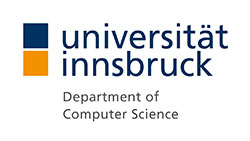Research is the core task of STI Innsbruck. Our motto is "Enabling Semantics". Find out more about our current research directions!
Archive
This page lists the current projects with STI Innsbruck. Please see the archive and the historical projects for more on completed projects.
Sustainable Electronic Human Resource Management (J3346) Website: http://www.epiqo.com
The growing interdisciplinary field of e-HRM (Electronic Human Resource Management) calls for inquiries into sustainable online career services. The depth of the contemporary sustainability issue of career services is compounded by a global pattern of shorter and temporary job contracts and increasing job switches, in particular among young professionals. Ever more applicants turn for advice and queries about their prospective career moves to online career services. Organizations progressively use online career services as a means to building relationships with young professionals, including those who have an interest in a specific organization, job type or branch, but who are currently not available for recruitment. The purpose of this research project is to provide a greater conceptual understanding and empirical validation of such relational behaviour. This empirically grounded analysis of antecedents of user commitment will fill a gap in our theoretical understanding of how job seekers perceive the universe of alternative jobs, and all too frequently switch costly strategies in their job-search efforts. Please see the following use case: |
SWING SWING aims at deploying Semantic Web Service (SWS) technology in the geospatial domain. In particular, we address two major obstacles that must be overcome for SWS technology to be generally adopted, i.e. to reduce the complexity of creating semantic descriptions and to increase the number of semantically described services. Today, a comprehensive knowledge of logics, ontologies, metadata and various specification languages is required to describe a service semantically. We will develop methods and tools that can hide the complexity - and automate the creation - of the necessary semantic descriptions. The objective of SWING is to provide an open, easy-to-use SWS framework of suitable ontologies and inference tools for annotation, discovery, composition, and invocation of geospatial web services. SWING builds on the DIP and SEKT IPs, by adopting, combining and reinforcing their results. A main key to the solution is adapting the SWS technology of DIP to handle geospatial services and content. Another key is utilising and advancing the technology of SEKT to annotate geospatial services with semantic information. A targeted synergy between these two research initiatives are demanded to maintain and extend Europe's leading role in SWS. The SWING framework and pilot application will increase the use of distributed and heterogeneous services in geospatial decision making. The results can be reused in other domains and will boost the availability of semantic services and bring the vision of the SWS a great leap forward. Exploitation of SWING's results will provide Europe's decision makers and citizens with a new paradigm of information retrieval and new business opportunities. |
TripCom Website: http://tripcom.sti2.at
The mission of TripCom is to take a significant move towards a new era of the Internet. The Internet was invented in the 1960's and provides a highly decentralized and scalable architecture for enabling large networks of computers beyond the boundaries of other communication protocols. The next step for the Internet is likely to be the direct integration of applications and computers via Web service technology. This network no longer directly interlinks humans but interlinks applications and programs to provide integrated services to the human end-user. However, current Web service technology has only very little to do with the Web. It is based on the message exchange paradigm similar to email communication. Truly Web-enabled Web services will communicate via persistent publication of information. Realizing this vision and a new technology is the mission of TripCom with the result being based on the integration of Tuple Space, Semantic Web (triple), and Web service technologies. To this end, we on the one hand plan to improve Tuple Space technology by adding semantics and means to structure and relate tuples in a scalable and linkable Triple Space architecture. On the other hand we plan to improve Web service technologies by adopting the flexible and powerful asynchronous communication model of Tuple Spaces. |
Triple Space Computing (TSC) Website: http://tsc.sti2.at/
Triple Space Computing is a very simple and powerful paradigm that inherits the communication model from Tuple Space Computing model and projects it in the context of the Semantic Web. Instead of sending messages forward and backward among participants, like most of today's web applications do, future triple-based applications will just use a simple communication based on writing and reading RDF triples in a shared space. Clever middleware is required to provide a virtual Global Semantic Space without requiring each application either to download or to search through the entire Semantic Web. Triple Space Computing as a new paradigm for coordination and communication compliant with the design principles of the Web, thus provides a major building block for the Semantic Web and for interoperation of Semantic Web services. |
Pages
Contact person in charge.

